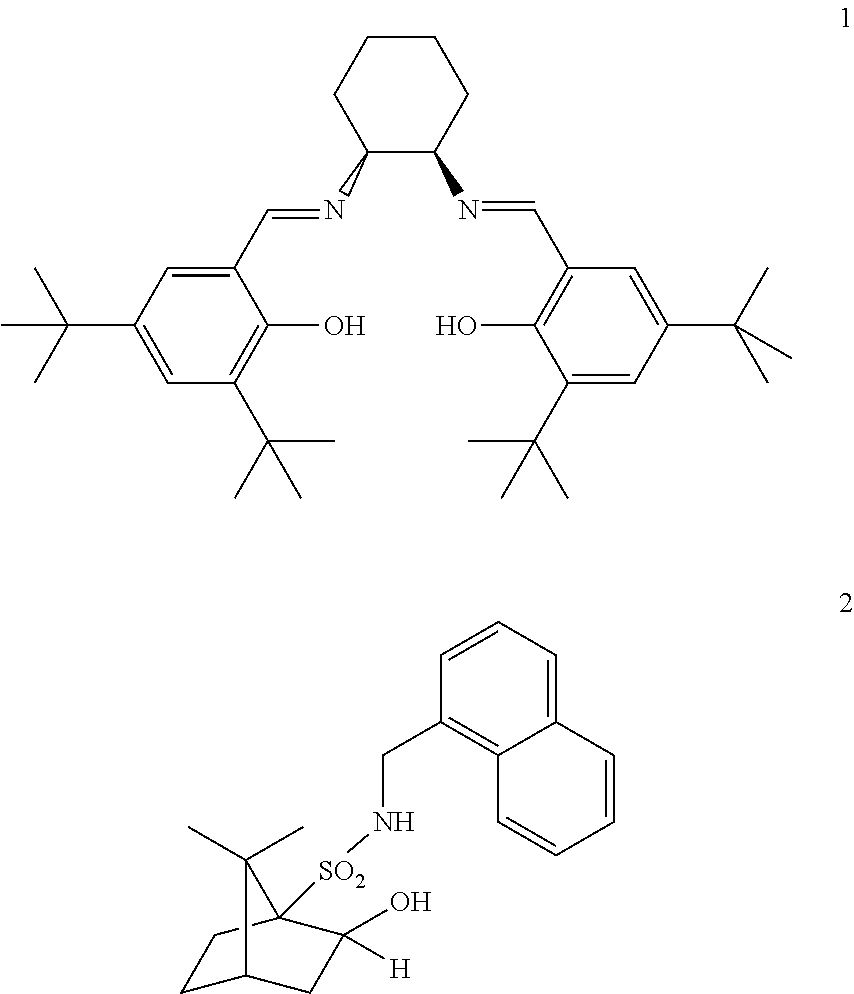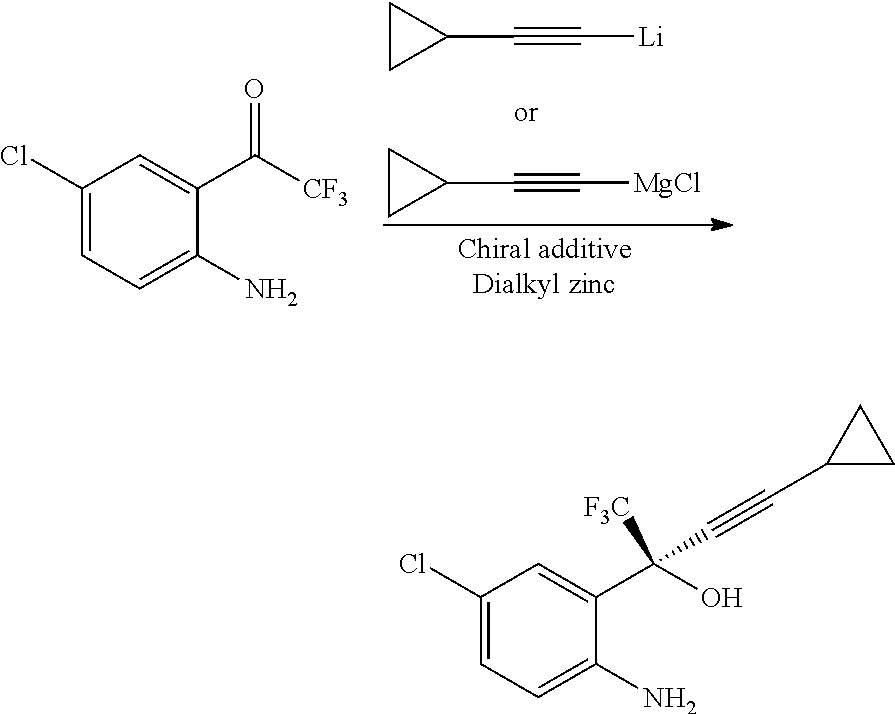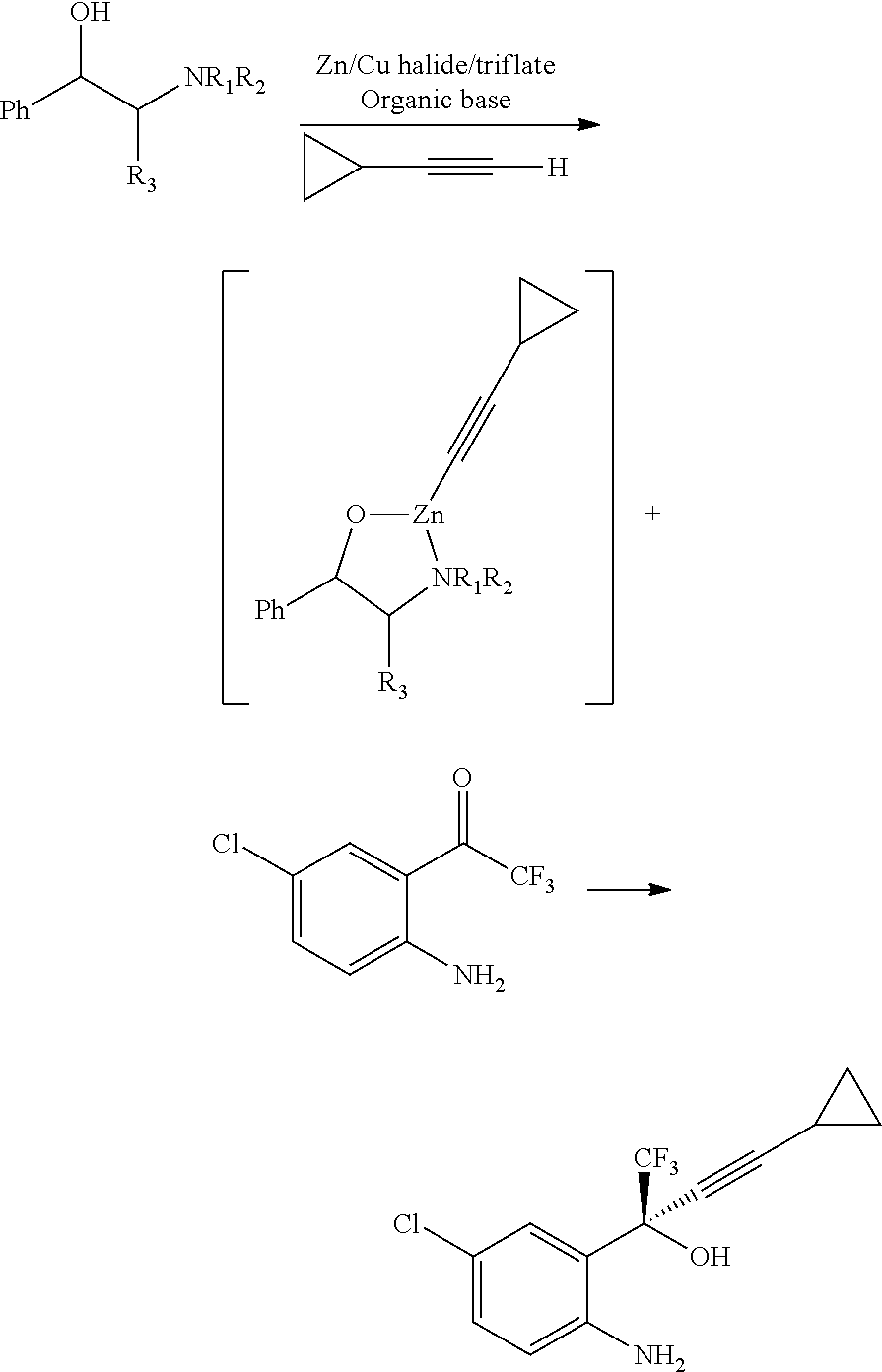Efficient process to induce enantioselectivity in procarbonyl compounds
a procarbonyl compound and enantioselectivity technology, applied in the preparation of organic compounds, group 4/14 element organic compounds, amino-hyroxy compounds, etc., can solve the problems of limited applicability in industrial scale synthesis of pharmaceutical intermediates, difficult storage, and difficult handling, and achieve high enantioselectivity and product yield
- Summary
- Abstract
- Description
- Claims
- Application Information
AI Technical Summary
Benefits of technology
Problems solved by technology
Method used
Image
Examples
example 1
Preparation of (S)-5-Chloro-α-(cyclopropylethynyl)-2-amino-α-(trifluoromethyl)benzene methanol of Formula
[0074]
Step A: A solution of chloromagnesium-cyclopropylacetylide (CPA-MgCl) was prepared by adding neat cyclopropyl acetylene (3.62 gms) to a stirred solution of n-butyl magnesium chloride (2M solution in tetrahydrofuran, 26.8 ml) at 0-5° C. The solution was stirred for another 2 hours at 0-5° C.
Step B: In another dry flask, to anhydrous tetrahydrofuran (80 ml) at 0-5° C., sodium hydride (57% dispersion in mineral oil, 4.71 gms) was added slowly. The mixture was stirred for 30 minutes at 25° C. to 30° C. and again cooled to 0° C. to 5° C. (1R,2S)-Pyrrolidinyl norephidrine (13.5 gms) and 2,2,2-trifluoroethanol (4.3 gm) were added and stirred for 60 minutes at 25° C. to 30° C. To the reaction mixture, was added a solution of zinc bromide (12 gms) in tetrahydrofuran (40 ml) and stirred for 60 minutes at 25° C. to 30° C., to obtain ephedrine zincate complex. The solution of chloromag...
example 2
Preparation of (S)-5-Chloro-α-(cyclopropylethynyl)-2-amino-α-(trifluoromethyl)benzene methanol (Using Zinc Chloride for Zincate Complex and Sodium Hydride and Magnesium Chloride for CPA-MgCl Complex)
Step A: Preparation of Chloromagnesium Complex of Cyclopropylacetylide:
[0075]In a 1 liter 4 necked round bottom flask was charged tetrahydrofuran (130 ml) and sodium hydride (27.2 gms) at 25° C. to 35° C. The mixture was cooled to 0° C. to 5° C. and a tetrahydrofuran solution of cyclopropyl acetylene (32.4 gms in 34 ml tetrahydrofuran) was added. The mixture was heated to 60° C. to 65° C. and stirred for 2 hours at same temperature. The mixture was then cooled to 25° C. to 35° C. and charged magnesium chloride (51.5 gms). The resulting mixture was stirred at 60° C. to 65° C. for 2 hours and then cooled to 25° C. to 35° C. to obtain the chloromagnesium complex of cyclopropylacetylide.
Step B: A 1 liter 4 necked round bottom flask was charged with tetrahydrofuran (200 ml), (1R,2S)-pyrrolidi...
example 3
Preparation of (S)-5-Chloro-α-(cyclopropylethynyl)-2-amino-α-(trifluoromethyl)benzene methanol (Using Zinc Acetate for Zincate Complex and Sodium Hydride and Magnesium Chloride for CPA-MgCl Complex)
Step A: Preparation of Chloromagnesium Complex of Cyclopropylacetylide:
[0079]In a 1 liter 4 necked round bottom flask was charged tetrahydrofuran (130 ml) and sodium hydride (27.2 gms) at 25° C. to 35° C. The mixture was cooled to 0° C. to 5° C. and a tetrahydrofuran solution of cyclopropyl acetylene (32.4 gms in 34 ml tetrahydrofuran) was added. The mixture was heated to 60° C. to 65° C. and stirred for 2 hours at same temperature. The mixture was then cooled to 25° C. to 35° C. and charged with magnesium chloride (51.5 gms). The mixture was stirred at 60° C. to 65° C. for 2 hours and then cooled to 25° C. to 35° C. to obtain the chloromagnesium complex of cyclopropylacetylide.
Step B: In a 1 liter 4 necked round bottom flask was charged tetrahydrofuran (200 ml), (1R,2S)-pyrrolidinyl nore...
PUM
| Property | Measurement | Unit |
|---|---|---|
| Electrical conductance | aaaaa | aaaaa |
| Electrical conductance | aaaaa | aaaaa |
Abstract
Description
Claims
Application Information
 Login to View More
Login to View More - R&D
- Intellectual Property
- Life Sciences
- Materials
- Tech Scout
- Unparalleled Data Quality
- Higher Quality Content
- 60% Fewer Hallucinations
Browse by: Latest US Patents, China's latest patents, Technical Efficacy Thesaurus, Application Domain, Technology Topic, Popular Technical Reports.
© 2025 PatSnap. All rights reserved.Legal|Privacy policy|Modern Slavery Act Transparency Statement|Sitemap|About US| Contact US: help@patsnap.com



